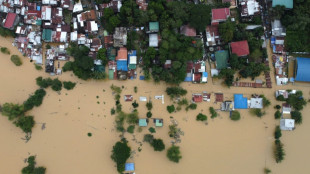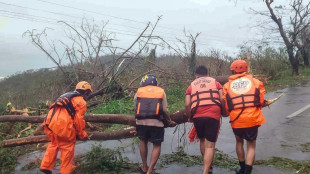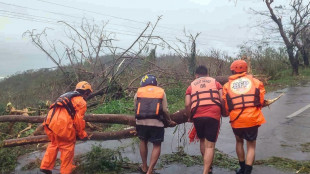
-
 Spanish resort to ban new holiday flats in 43 neighbourhoods
Spanish resort to ban new holiday flats in 43 neighbourhoods
-
Hong Kong to sentence dozens of democracy campaigners

-
 Russian extradited to US from SKorea to face ransomware charges
Russian extradited to US from SKorea to face ransomware charges
-
Phone documentary details Afghan women's struggle under Taliban govt

-
 G20 wrestles with wars, 'turbulence' in run-up to Trump
G20 wrestles with wars, 'turbulence' in run-up to Trump
-
Kane hoping to extend England career beyond 2026 World Cup

-
 Gazans rebuild homes from rubble in preparation for winter
Gazans rebuild homes from rubble in preparation for winter
-
'Vague' net zero rules threaten climate targets, scientists warn

-
 Stocks, dollar hesitant as traders eye US rate outlook, Nvidia
Stocks, dollar hesitant as traders eye US rate outlook, Nvidia
-
G20 wrestles with wars, climate in run-up to Trump

-
 'Agriculture is dying': French farmers protest EU-Mercosur deal
'Agriculture is dying': French farmers protest EU-Mercosur deal
-
Beyonce to headline halftime during NFL Christmas game

-
 Rescuers struggle to reach dozens missing after north Gaza strike
Rescuers struggle to reach dozens missing after north Gaza strike
-
Russia vetoes Sudan ceasefire resolution at UN

-
 G20 host Brazil launches alliance to end 'scourge' of hunger
G20 host Brazil launches alliance to end 'scourge' of hunger
-
Stocks, dollar hesitant as traders scale back US rate cut bets

-
 Trump confirms plan to use military for mass deportation
Trump confirms plan to use military for mass deportation
-
Schools closed in Beirut after deadly Israeli air raid

-
 Anger, pain in Turkey as 'newborn deaths gang' trial opens
Anger, pain in Turkey as 'newborn deaths gang' trial opens
-
Kremlin says Biden 'fuelling' war as Russian strikes rock Odesa

-
 UN climate chief at deadlocked COP29: 'Cut the theatrics'
UN climate chief at deadlocked COP29: 'Cut the theatrics'
-
G20 leaders gather to discuss wars, climate, Trump comeback

-
 Stocks, dollar mixed as traders scale back US rate cut bets
Stocks, dollar mixed as traders scale back US rate cut bets
-
Stoinis lets rip as Australia crush Pakistan for T20 series whitewash

-
 Bentancur banned for seven games over alleged racial slur
Bentancur banned for seven games over alleged racial slur
-
Kremlin says Biden 'fuelling' tensions with Kyiv missile decision

-
 COP host Azerbaijan jailed activists over 'critical opinions': rights body
COP host Azerbaijan jailed activists over 'critical opinions': rights body
-
Composer of Piaf's 'Non, je ne regrette rien' dies aged 95

-
 South African trio nominated for World Rugby player of year
South African trio nominated for World Rugby player of year
-
'Not here for retiring': Nadal insists focus on Davis Cup

-
 Tractor-driving French farmers protest EU-Mercosur deal
Tractor-driving French farmers protest EU-Mercosur deal
-
Floods hit northern Philippines after typhoon forces dam release

-
 Pakistan skittled for 117 in final T20 against Australia
Pakistan skittled for 117 in final T20 against Australia
-
Schools closed in Beirut after deadly Israeli strike

-
 Chris Wood hits hat-trick in NZ World Cup qualifying rout
Chris Wood hits hat-trick in NZ World Cup qualifying rout
-
Markets mixed after Wall St losses as traders weigh US rates outlook

-
 US, Philippines sign deal on sharing military information
US, Philippines sign deal on sharing military information
-
Bangladeshi ex-ministers face 'massacre' charges in court

-
 Law and disorder as Thai police station comes under monkey attack
Law and disorder as Thai police station comes under monkey attack
-
Disgraced Singapore oil tycoon sentenced to nearly 18 years for fraud

-
 Philippines cleans up as typhoon death toll rises
Philippines cleans up as typhoon death toll rises
-
Quincy Jones awarded posthumous Oscar

-
 'Critically endangered' African penguins just want peace and food
'Critically endangered' African penguins just want peace and food
-
Long delayed Ukrainian survival video game sequel set for release amid war

-
 Star Australian broadcaster charged with sex offences
Star Australian broadcaster charged with sex offences
-
Philippines cleans up after sixth major storm in weeks

-
 Woman-owned cafe in Indonesia's Sharia stronghold shakes stigma
Woman-owned cafe in Indonesia's Sharia stronghold shakes stigma
-
Indigenous Australian lawmaker who heckled King Charles censured

-
 End of an era as Nadal aims for winning Davis Cup farewell
End of an era as Nadal aims for winning Davis Cup farewell
-
Trump taps big tech critic Carr to lead US communications agency

| RBGPF | 2.67% | 61.84 | $ | |
| CMSD | -0.06% | 24.425 | $ | |
| BCC | 0.75% | 141.145 | $ | |
| JRI | 1.06% | 13.24 | $ | |
| RYCEF | 1.02% | 6.85 | $ | |
| CMSC | 0.2% | 24.62 | $ | |
| SCS | 0.56% | 13.305 | $ | |
| RIO | 1.99% | 62.215 | $ | |
| NGG | -0.02% | 62.74 | $ | |
| RELX | 1.36% | 45.065 | $ | |
| BCE | 1.36% | 27.19 | $ | |
| GSK | 1.21% | 33.76 | $ | |
| AZN | 0.19% | 63.35 | $ | |
| VOD | 1.74% | 8.925 | $ | |
| BP | 1.63% | 29.46 | $ | |
| BTI | 0.59% | 36.605 | $ |

Rights court condemns Peru over one of world's most polluted towns
The Inter-American Court of Human Rights said Friday that Peru had violated residents' "right to live in a healthy environment" in an Andean mining town that is considered one of the most polluted places on earth.
The Andean city of La Oroya, situated in a high-altitude valley at 3,750 meters (12,300 feet), is home to a heavy metal smelter that has poisoned residents and the environment for almost a century.
In 2006, La Oroya residents sued the Peruvian government at the Inter-American Commission on Human Rights for allowing the company to pollute at will.
Since then, the town has often featured on lists of the most polluted places on the planet, rubbing shoulders with sites like Ukraine's nuclear-sullied Chernobyl and Russia's Dzerzhinsk, the site of Cold War-era factories producing chemical weapons.
In its ruling, which is binding, the Costa Rica-based court blamed the Peruvian State "for the violation of the rights to a healthy environment, health, personal integrity, a dignified life... in detriment of the 80 victims" who filed the lawsuit.
The court ordered that Peru carry out an analysis of the contamination of the air, water and soil in La Oroya, provide free medical care to the victims, and adapt the allowed standards for lead, sulfur dioxide, arsenic, mercury and particulate matter.
Since 1922, the gigantic smelter that was long the economic heartbeat of La Oroya, has processed copper, zinc, lead, gold, selenium, and other minerals from nearby mines.
The court said the complex "has had a significant impact on the environment, contaminating the air, water and soil."
The ruling also said that "exposure to lead, cadmium, arsenic and sulfur dioxide constituted a significant risk to the health of the victims, and they did not receive adequate medical care from the State."
According to the International Federation for Human Rights, in 2013, 97 percent of La Oroya children between six months and six years of age, and 98 percent between age seven and 12, had elevated levels of lead in their blood.
The smelting complex went bankrupt in 2009 -- crippling the town's economy -- but re-opened last year under the management of a company made up of almost 1,300 shareholders -- many of whom are former foundry workers.
The new administration has promised not to pollute the town.
W.Morales--AT




